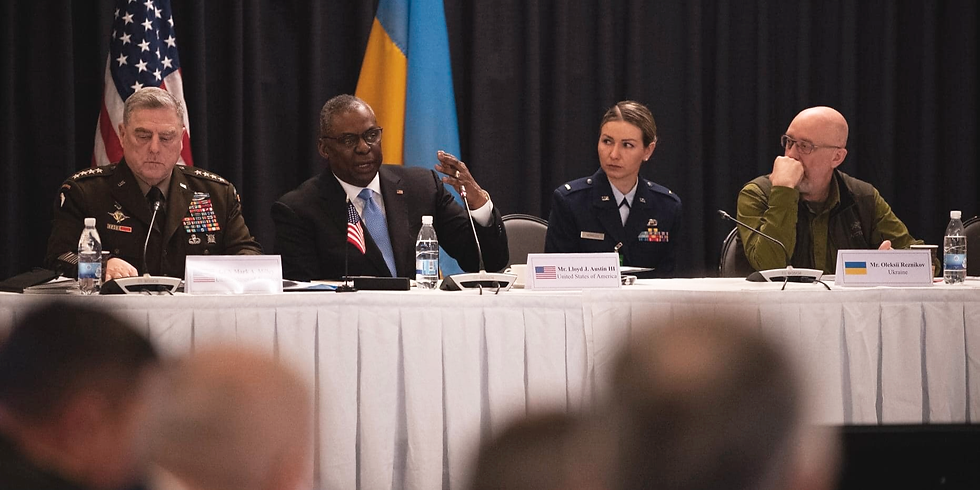Summary of the Defence Ministers' Summit in Ramstein, Germany
- EESF

- Apr 27, 2022
- 4 min read
Updated: Mar 13
The war in Ukraine has forced Western countries to think about new solutions in the field of international security. Final decisions will be made on the basis of experience gained during the war, but preliminary conclusions and necessary interim measures are being taken right now.

Place, Participants
On Tuesday, April 26, 2021, heads and representatives of defense ministries from more than 40 countries met at the U.S. military base in Ramstein, Germany, to discuss how they could coordinate military assistance to Ukraine, both for immediate defense needs and in the future.
In addition to representatives from NATO member states, defense officials from Africa, Asia and the Middle East (Australia, Japan, Israel, Tunisia, etc.), as well as Finland and Sweden, attended the event. Thus, the list of participants was overwhelmingly representative.
NATO Secretary General Jens Stoltenberg also attended.
Goals and objectives of the summit
The global goal of the summit can be seen as developing a strategy to further weaken Russia to the point that it will no longer be capable of such an invasion as in Ukraine.
What is striking here is that it is no longer just about pressuring Russia in connection with the war in Ukraine. The goal is broader – Russia as an aggressor state must be weakened in principle and in the long term.
In connection with the set global goal, the summit solves quite clear foreign policy and military/organizational goals.
Foreign policy objective 1 is the formation of a coalition of world nations, ready to actively resist Russian aggression, under the overall leadership of the United States.
In this regard, it should be emphasized that the summit is a continuation and deepening of the foreign policy approach chosen by President Biden and Secretary Blinken back in 2020. This approach is strikingly different from that used during the long years of "soft power" and "resetting" of the Obama cabinet, as well as from the emphatically isolationist policies of Donald Trump. A landmark fact is that the meeting was initiated by Pentagon chief Lloyd Austin, the U.S. secretary of defense.
The involvement of previously neutral and militarily and economically powerful countries such as Sweden, Japan and African countries in the orbit of action is a clear U.S. foreign policy success, especially if we consider the practical nature of the decisions made at the summit.
Foreign Policy Objective 2
According to BBC diplomatic correspondent Paul Adams, the meeting is a deliberate demonstration of international solidarity with Ukraine amid the decisions made by a number of countries supporting Ukraine to send heavy and most modern weapons there.
Foreign Policy Objective 3
Formally the host and organizer of the meeting was the United States, but the choice of the German town Ramstein (an airbase where the U.S. Air Force Command in Europe and the NATO Air Force Command are located) as a meeting place was not accidental. The event was planned to increase the already considerable international pressure on the German government to allow the delivery of heavy weapons to Ukraine.
Military/organizational Objective 1
Developing the tools to help Ukraine to:
- winning the war
- stay strong after the war ends
Military/organizational Objective 2
The meeting should develop a new common strategy for dealing with Russia's aggression.
Results achieved
It is obvious that the U.S. was able to ensure that the meeting was not just symbolic, but also led to concrete results:
The U.S. and its partners confirmed their willingness to step up their support for Ukraine at a record pace. Partner countries have already raised about $5 billion in military aid to Ukraine, of which $3.7 billion is being allocated by the U.S. administration.
This meeting also marked the founding of a contact group, which will include representatives of the countries participating in the meeting in Ramstein. Not only NATO member states, but also a number of neighboring countries, such as Japan and Israel, are included. It is planned that this contact group will meet monthly to coordinate military assistance and discuss Ukraine's strategy for defeating Russia.
The Pentagon chief said he expects Ukraine to eventually apply for NATO membership and stressed that the bloc will not abandon its open door policy.
Apparently, the German Government is beginning to change its position. At a meeting on April 26, German Defense Minister Christine Lambrecht, who had hindered the process of providing military and technical assistance to Ukraine, circulated a written statement, according to which the German government will supply Ukraine with about 50 Gepard self-propelled air defense systems. Lambrecht also confirmed the German government's intention to provide new weapons to countries that send their old arsenal to Ukraine. In addition, the Bundeswehr intends to train the Ukrainian military in the territory of Germany to handle Western equipment, including not only "Gepards," but also, for example, self-propelled PzH2000 howitzers, which the Netherlands and Germany intend to supply to Ukraine.
A coordination center has been created at the United States European Command in Stuttgart, Germany, to oversee arms deliveries to Ukraine. The task of the new structure is to coordinate and speed up arms deliveries to Kiev from more than 40 countries.
Further pressure on Russia is expected: On Wednesday, April 27, British Foreign Secretary Liz Truss will call on countries that have condemned Russia's invasion of Ukraine to double their support for Kiev and, among other things, to deliver promised supplies of heavy weapons, including tanks and planes, to stop this aggression. Truss also calls for using the experience of this war as a catalyst for establishing a new international security framework.





